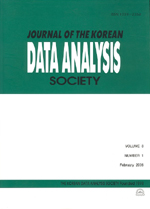세분화된 고객별 신용평점모형의 개발
Development of Personal Credit Scoring Models by Grouped Customers
- 한국자료분석학회
- Journal of The Korean Data Analysis Society (JKDAS)
- Vol.17 No.6
-
2015.123003 - 3014 (12 pages)
- 36

금융기관은 대출자산의 건전성을 제고하기 위한 많은 전략과 시스템을 운영하고 있으며, 그 중 신용거래에 있어서 발생할 수 있는 위험의 사전 예측과 우량고객 유치 등 위험관리 및 효율성과 수익성 제고를 위한 신용평점모형 구축은 금융기관의 미래 수익과 직결된다고 할 수 있다. 따라서 신용평점모형 개발 시 대출자산 규모를 늘릴 수 있으면서 고객의 부실가능성을 얼마나 잘 예측해낼 수 있는가에 대해 중요과제로 여기고 개발에 많은 노력을 기울인다. 본 연구에서는 신청평점시스템의 목적에 부합하는 신용평점모형 개발과정을 로지스틱 회귀분석을 활용하여 살펴보고 신용평점모형의 안정성 및 변별력에 대한 검정방법으로 널리 사용되고 있는 Kolmogorov- Smirnov, AUROC, AR, PSI 등과 같은 통계량들의 판단기준을 통해 기존 모형과 세분화된 모형을 비교 분석한다. 또한 로지스틱 회귀모형을 구축하는데 적합성을 높이기 위한 평점표(score card) 평가항목의 질적 향상과 선정기준을 제안하고 최적의 신용평점모형을 제시한다.
Financial institutions operate many strategies and systems to raise the quality of their loan portfolios. Credit scoring models, which they use to forecast the risk of credit transactions, attract good customers, and raise their efficiency and profitability, can be directly connected with their future profits. Therefore, when they are developing credit scoring models, they make a great deal of effort to increase the size of the loan portfolio and reduce the potential insolvency of customers. This study is designed to study the process of developing credit scoring models suitable for the purpose of application scoring system by utilizing logistic regression. This study also seeks to compare and analyze existing models and segmented models by utilizing such criteria on test statistics as Kolmogorov-Smirnov, AUROC, AR, and PSI that are widely used to verify the discriminating ability and stability of credit scoring models. It also suggests methods needed to improve the quality of evaluation items on score cards used in order to increase the suitability of logistic regression models, criteria for selecting evaluation items, and optimal credit scoring models.
1. 서론
2. 신용평점시스템
3. 데이터
4. 분석
5. 결론
References
(0)
(0)